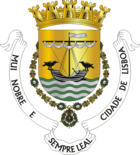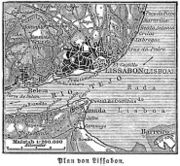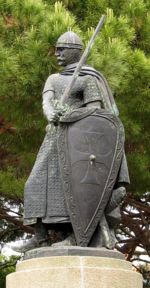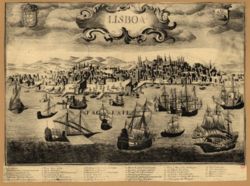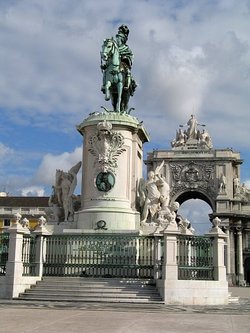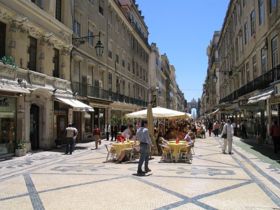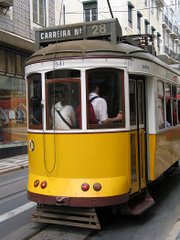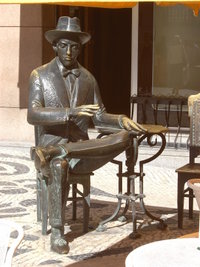Lisbon
2007 Schools Wikipedia Selection. Related subjects: European Geography
|
||||
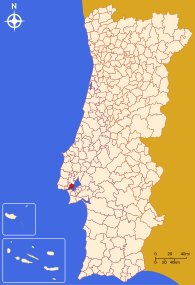 |
||||
| Location | ||||
| - Country | Portugal | |||
| - Region | Lisbon | |||
| - Subregion | Grande Lisboa | |||
| - District or A.R. | Lisbon | |||
| Mayor | Carmona Rodrigues | |||
| - Party | PSD | |||
| Area | 84.8 km² | |||
| Population | ||||
| - Total | 564,477 (2,800,000 in metro) | |||
| - Density | 6,368/km² | |||
| No. of parishes | 53 | |||
| Coordinates | 38º42'N 9º11'W | |||
| Municipal holiday | Saint Anthony June 13 |
|||
| Website: http://www.cm-lisboa.pt | ||||
Lisbon (Portuguese: Lisboa, IPA: [liʒ'boɐ]) is the capital and largest city of Portugal. It is the seat of the district of Lisbon and capital of Região Lisboa (Lisbon Region). Lisbon municipality has a population of 564,477, and the Lisbon Metropolitan Area in total has around 2,800,000 inhabitants, the largest urban aglomeration of Portugal. Lisbon Region is the wealthiest region in Portugal and it is well above the European Union's per capita GDP average.
Lisbon hosts two important European Union agencies namely, the European Monitoring Centre for Drugs and Drug Addiction (EMCDDA) and the European Maritime Safety Agency ( EMSA). The CPLP ( Community of Portuguese Language Countries), is also headquartered in Lisbon.
Geography and location
Location
Lisbon is situated at 38°43' north, 9°8' west, making it the westernmost capital in mainland Europe. It is located in the west of the country, on the Atlantic Ocean coast at the point where the river Tagus flows into the Atlantic Ocean. The city occupies an area of 84.6 km². The city boundaries, unlike those of most major cities, are narrowly defined around the historical city perimeter. This gave rise to the existence of several administratively defined cities around Lisbon, such as Loures, Odivelas, Amadora and Oeiras, which in fact are part of the metropolitan perimeter of Lisbon.
The historic centre of Lisbon is built on seven hills, making some of the city's streets too steep for motor vehicles; the city is served by three funicular services and one elevator. The western side of the city is mainly occupied by the Monsanto Forest Park, one of the largest urban parks in Europe with an area close to 10 square kilometres (almost 4 square miles).
Parishes
There are 53 as freguesias ( civil parishes) in Lisbon:
|
|
|
History
Neolithic era to the Roman Empire
During the Neolithic the region was inhabited by the Iberians, who also lived in other regions of Atlantic Europe at the time. They built religious monuments called megaliths. Dolmens and Menhirs still survive in the countryside around the city. The Celts invaded after the first millennium BC and intermarried with the Iberians, giving rise to Celtic-speaking local tribes such as the Cempsi.
Archeological findings show that a Phoenician trading post existed in the place that, since 1200 B.C., has occupied the centre of the city, in the southern slope of the Castle Hill. The magnificent natural harbour provided by the estuary of the river Tagus made it the ideal spot for a settlement to provide foodstuffs to Phoenician ships travelling to the tin islands (modern Isles of Scilly) and Cornwall. The new city was named Allis Ubbo or "safe harbour" in Phoenician, according to one of several theories for the origin of its name. Besides sailing to the North, the Phoenicians also probably took advantage of the situation of the new colony at the mouth of Iberia's largest river to trade with the inland tribes for valuable metals. Other important local products were salt, salted fish and the then widely famous Lusitanian horses. Recently, Phoenician remains from the eighth century B.C. were found beneath the Middle Age Sé de Lisboa or main Cathedral of the modern city.
The Greeks knew Lisbon as Olissipo and "Olissipona", a name they thought was derived from Ulysses or also know as Odiseo for roman people , though this was a folk etymology; according to an Ancient Greek myth, the hero Ulysses founded the city after he left Troy and departed to the Atlantic to escape the Greek coalition. If all of Odysseus's travels were in the Atlantic as Cailleux hypothesized, then this could mean that Odysseus founded the city coming from the north, before trying to round Cape Malea, which Cailleux located at Cabo de São Vicente, in a south-east direction, to reach his home land Ithaca, supposedly present Cadiz. However, the foundation of the city by the Phoenicians is thought to predate any Greek presence in the area. Later on the Greek name was corrupted in vulgar Latin to Olissipona.
Roman Empire to the Moorish conquest
During the Punic wars, after the defeat of Hannibal (whose troops included members of the Conii) the Romans decided to deprive Carthage in its most valuable possession, Hispania (the name given by the Romans to the whole of the Iberian Peninsula). After the defeat of the Carthaginians by Scipio Africanus in Eastern Hispania, the pacification of the West was led by Consul Decimus Junius Brutus. He obtained the alliance of Olissipo which sent men to fight alongside the Legions against the Celtic tribes of the Northwest. In return, Olissipo was integrated in the Empire under the name of Felicitas Julia, a Municipium Cives Romanorum. It was granted self-rule over a territory going as far away as 50 kilometres (30 miles), exempted from taxes, and its citizens given the privileges of Roman citizenship. It was in the newly created province of Lusitania, whose capital was Emerita Augusta. The attacks by the Lusitanians during the frequent rebellions over the next couple of centuries weakened the city and a wall was built.
During the time of Augustus the Romans built a great Theatre; the Cassian Baths underneath the current Rua da Prata; Temples to Jupiter, Diana, Cybele, Tethys and Idae Phrygiae (an uncommon cult from Asia Minor), besides temples to the Emperor; a large necropolis under Figueira Plaza; a large Forum and other buildings such as insulae (multi-storied apartment buildings) in the area between the modern Castle Hill and Downtown. Many of these ruins were first unearthed during the middle Eighteenth century, when the recent discovery of Pompeii made Roman Archeology fashionable among Europe's upper classes.
Economically Olissipo was known for its garum, a sort of fish sauce highly prized by the elites of the Empire and exported in Amphorae to Rome and other cities. Wine, salt and its famously fast horses were also exported. The city came to be very prosperous through suppression of piracy and technological advances, which allowed a boom in the trade with the newly Roman Provinces of Britannia (particularly Cornwall) and the Rhine, and through the introduction of higher civilization to the tribes living by the river Tagus in the interior of Hispania. The city was ruled by an oligarchical council dominated by two families, the Julii and the Cassiae. Petitions are recorded addressed to the Governor of the province in Emerita and to the Empreror Tiberius, such as one requesting help dealing with "sea monsters" allegedly responsible for shipwrecks. Roman Lisbon's most famous son was Sertorius who led a large rebellion against Dictator Sulla early in the Roman Period. Among the majority of Latin speakers lived a large minority of Greek traders and slaves. The city was connected by a broad road to Western Hispania's two other large cities, Bracara Augusta in the province of Tarraconensis (today's Portuguese Braga), and Emerita Augusta, the capital of Lusitania (now Mérida in Spain).
In matters of religion, the city followed the mainstream Roman Polytheist cults, but with special attention paid to the god of Medicina ( Asclepius), the Moon goddess Cybele, and a local lizard and snake divinity.
Olissipo, like most great cities in the Western Empire, was a centre for the dissemination of Christianity. Its first Bishop was Saint Gens, and there were several martyrs killed by the pagans during the great persecutions; Maxima, Verissimus and Julia are the most significant names.
At the end of the Roman domain, Olissipo was one of the first Christian cities. The first bishop was named Saint Gens, whose name is still carried by one of Lisbon's hills. It suffered invasions from Alans, Vandals and Sueves before eventually being included in the Visigoth kingdom of Toledo and called Ulishbona.
Moorish Rule
In approximately 711 Lisbon was taken by the Moors (it was called al-ʾIšbūnah in Arabic الأشبونة), under whose rule the city flourished. The Moors, who were Muslims from North Africa and the Middle East, built many mosques and houses as well as a new city wall, currently named the Cerca Moura. The city kept a diverse population including Christians, Berbers, Arabs, Jews and Saqalibas.
Arabic was forced on the Christians as the official language. Mozarabic was the mother tongue spoken by the Christian population. Islam was the official religion practiced by the Arabs and Muladi (muwallad), the Christians could keep their religion but under heavy Dhimmi status and were forced to pay the jizyah.
The Moorish influence is still present in Alfama the old part of Lisbon that survived the 1755 Lisbon earthquake. Many placenames are derived from Arabic; the Alfama, the oldest existing district of Lisbon, for example, is derived from the Arabic "al-hamma".
For a brief time during the Taifa period Lisbon was the centre town in the Regulo Eslavo of the Taifa of Badajoz while rulled by Sabur al-Saqlabi (Sabur the Slav) son of Sabur al-Jatib , a Slav that had been at the service of al-Hakam II.
In 1147, as part of the Reconquista, a group of combined French, English, German, and Portuguese knights, led by Afonso I of Portugal, sieged and reconquered Lisbon. Lisbon was now back in Christian hands.
The reconquest of Portugal and re-establishment of Christianity is one of the most significant events in Lisbon's history. Arabic lost its place in everyday life, and Portuguese was again the main language. Any remaining Muslim population were gradually converted to Roman Catholicism, or expelled , and the mosques were turned back into churches.
From the Middle Ages to the Portuguese Empire
It received its first Foral in 1179, and became the capital city of Portugal in 1255 due to its central location in the new Portuguese territory.
During the last centuries of the Middle Ages, the city expanded substantially and became an important trading post with both northern Europe and Mediterranean cities.
A university school at Lisbon was originally founded in 1290 by Dinis I of Portugal as Estudo Geral (General Study) (today the University of Coimbra), being transferred several times to Coimbra where it was installed definitively in the 16th century. The city refounded its own university in 1911 after centuries of inactivity in Lisbon, incorporating reformed former colleges and other non-university higher education schools of the city (such as the Escola Politécnica). Today there are 3 public universities in the city ( University of Lisbon, Technical University of Lisbon and New University of Lisbon) and a public university institute ( ISCTE) - see list of universities in Portugal.
Most of the Portuguese expeditions of the age of discovery left from Lisbon during the XV to XVII centuries, including Vasco da Gama's departure to India in 1497.
The 16th century marks the golden age for Lisbon. The city became the European hub of commerce with the Far East, while gold from Brazil also flooded into the city. See Portuguese Empire.
The 1640 restoration revolt takes place in Lisbon (see Philip III of Portugal).
On 26 January 1531 the city was hit by an earthquake which killed thousands.
On 1 November 1755 Lisbon was destroyed by another earthquake, which killed between 60,000 and 90,000 people and destroyed eighty-five percent of the city . Voltaire wrote a long poem, "Poême sur le désastre de Lisbonne", shortly afterwards, and mentioned the earthquake in his 1759 novel Candide (indeed, many argue that this critique of optimism was inspired by that earthquake). Oliver Wendell Holmes, Sr. also mentions it in his 1857 poem, The Deacon's Masterpiece, or The Wonderful One-Hoss Shay.
After the 1755 earthquake, the city was rebuilt largely according to the plans of the Marquês de Pombal; hence the designation of the lower town as Baixa Pombalina. Instead of rebuilding the medieval town, Marques de Pombal decided to demolish the remains of the earthquake and rebuild the down town in accordance with modern urban rules.
19th and 20th centuries
In the first years of the 19th century, Portugal was invaded by the troops of Napoleon Bonaparte and king John VI of Portugal temporarily fled to Brazil. Considerable property was pillaged by the invaders. The city felt the full force of the Portuguese liberal upheavals, beginning its tradition of cafés and theatres. In 1879 the Avenida da Liberdade was opened, replacing a previous public garden.
Lisbon was the centre of the republican coup of October 5, 1910 which instated the Portuguese Republic. Previously, it was also the stage of the regicide of Carlos I of Portugal ( 1908).
During World War II Lisbon was one of the very few neutral, open European Atlantic ports, a major gateway for refugees to the U.S. and a spy nest.
In 1974, Lisbon was the central destination point of the Carnation Revolution maneuvers, the end of the Portuguese Corporative Regime ( Estado Novo).
In 1988, a fire near the historical centre of Chiado greatly disrupted normal life in the area for about 10 years.
In 1994, Lisbon was the European Capital of Culture.
Expo '98 was held in Lisbon. The timing was intended to commemorate the 500th anniversary of Vasco da Gama's sea voyage to India.
The Lisbon Agenda was an European Union agreement on measures to revamp the EU economy, signed in Lisbon at an EU summit in 1999.
Contemporary Events
Lisbon hosted the 27th Taizé New Year European Meeting from 28th December 2004 to 1st January 2005.
Every March the city hosts the world-famous Lisbon Half Marathon, one of the most attended events of its kind in the world.
It regularly hosts countless other international events including various NATO, European Union and other summits.
In January 2006, Lisbon was the starting city of the Dakar Rally.
Rock in Rio was held in Lisbon twice, hosting concerts of many high profile singers and bands, such as Metallica, Shakira, Guns N' Roses, Roger Waters and many more.
Climate
Lisbon is one of the warmest European capitals. Spring and summer months are usually sunny with maximum temperatures close to 35º-40 °C during July and August and lows between 15 and 20 °C. Autumn and winter are typically rainy and windy with some sunny days; the temperature rarely falls below 5 °C, usually staying at an average of 10 °C. However, snowfall can occur. The latest one happened on January 29th 2006. On average, there are 3300 sunny hours per year and 100 days with rain per year. Lisbon's climate is strongly influenced by the Gulf Stream.
Sport
The sports clubs Sport Lisboa e Benfica and Sporting Clube de Portugal, playing in many sports in the highest Portuguese divisions and the European competitions, are from Lisbon. Belenenses, another important sports club with a great tradition in Portuguese sport, is also from the Portuguese capital.
Football is the most popular sport in Lisbon. Major football clubs include SL Benfica, with its home stadium the UEFA 5-Star Stadium Estádio da Luz (The Stadium of Light), which has 65,000 seats. Benfica has won the UEFA Champions League, the most prestigious title in European football, twice, and have appeared in the final seven times. Famous players range from Eusébio (in the 60's) to Rui Costa, Nuno Gomes, Simão Sabrosa and many others.
Sporting Lisbon is the other major football team from the city; they also play in a UEFA 5-Star stadium. The have won the UEFA Cup Winners Cup once and they were the UEFA Cup Finalist. They play in the Estádio José de Alvalade (Século XXI) which seats 52,000. The stadium colours are green and white. Former famous players range from Luís Figo to Cristiano Ronaldo.
Belenenses is the third biggest football team in the city, playing out of the Estádio do Restelo in the Belém district of Lisbon. Although they compete in the Superliga along with Benifca and Sporting, they only live in the shadows of their great rivals with a significantly smaller fanbase and trophy cabinet to match.
Indoor football, or futsal, is probably the secon most watched sport in Lisbon, and with four teams in the top flight 1a Divisão de Futsal its no suprise. The big three sports clubs Belenenses, Benfica and Sporting all compete professionally, while they are joined in the elite league by amateur club Sport Lisboa e Olivais.
Handball is incresingly popular in Portugal and indeed Lisbon since the 2003 World Championship final was played at the Pavilhão Atlântico. Belenenses, Benfica and Sporting CP all play in the elite Liga Portuguesa de Andebol. Professional basketball has a significant following in Lisbon, with Benfica and Belenenses both representating Lisbon in the top-flight LCB league.
Another popular indoor sport is roller hockey which, following the incredible success of the national team, has a huge following in the city especially those who support Lisbon's biggest club Benfica who compete in the Campeonato Portugues de Hoquei.
Obviously there are many other sport facilities in Lisbon, most notably for sailing, golf, mountain-biking, etc.
Demographics
The population of the city proper was 564,477 and the metropolitan area ( Lisbon Metropolitan Area) was 2,800,000 according to INE (National Institute of Estatistics). The Lisbon Metropolitan Area coincides with two NUTS II units, Grande Lisboa (Greater Lisbon), in the northern bank of the Tagus, and Península de Setúbal (Setúbal Peninsula), to the south, which are the two subregions of Região Lisboa (Lisbon Region). The population density of the city itself is 6,658 inhabitants per km². Lisbon Metropolitan Area is one of the fastest growing metropolitan areas in Europe, and estimates by the UN suggest that its population could grow to as much as 4.5 Million inhabitants by 2050. This figure, however, is viewed by many as somewhat optimistic.
Culture and sights
The heart of the city is the Baixa or city centre; this area of the city is being considered for UNESCO World Heritage Site status. The Baixa is organised in a grid system and a network of squares built after the 1755 Lisbon earthquake, which levelled a big part of the medieval town. The Castle of São Jorge and the Lisbon Cathedral are located on one of the seven hills of Lisbon, to the east of the Baixa. The oldest district of the city is Alfama, close to the Tagus, which has made it relatively unscathed through the various earthquakes.
Other monuments include: The Castle of São Jorge, atop the tallest hill of the central city, Praça do Comércio (Commerce Square) with the beautiful façade of the Church of Nossa Senhora da Conceição Velha nearby, Rossio Square, Restauradores Square, Elevador de Santa Justa, an elevator (lift) in Gothic revival style, built around 1900 to connect the Baixa and Bairro Alto, the richly-decorated Church of São Roque, Jerónimos Monastery, Belém Tower, Padrão dos Descobrimentos (Monument of the Discoveries) and Carmo Convent.
The city of Lisbon is rich in architecture; Romanesque, Gothic, Manueline, Baroque, Traditional Portuguese, Modern and Post-Modern constructions can be found all over the city. The city is also crossed by great boulevards and monuments along these main thoroughfares, particularly in the upper districts; notable among these are the Avenida da Liberdade, Avenida Fontes Pereira de Mello, Avenida Almirante Reis and Avenida da República.
Notable among the city's museums are:
The Museu Nacional de Arte Antiga (National Museum of Ancient Art); the Museu dos Azulejos (Museum of Portuguese-style Tile Mosaics); the Museu Calouste Gulbenkian (Calouste Gulbenkian Museum, containing varied collections of ancient and modern art); the Lisbon Oceanarium (Oceanário de Lisboa, the largest in Europe); the Museu do Design at Centro Cultural de Belém (Design Museum); the Museu Nacional dos Coches (National Coach Museum, containing one of the largest collections of royal coaches in the world) and the Museu da Farmácia (Pharmacy Museum).
Lisbon's opera house, the Teatro Nacional de São Carlos, hosts a relatively active cultural agenda, mainly in autumn and winter. Other important theatres and musical houses are the Centro Cultural de Belem, the Teatro D. Maria and the Gulbenkian Foundation.
The monument to Christ the King (Cristo Rei) stands on the left side of the river, in Almada. With open arms, overlooking the whole city, it resembles the Corcovado monument in Rio de Janeiro, and was built after World War II, as thanks for Portugal's being spared the horrors and destruction of the war.
Every June there are some 5 days of popular street celebrations in memory of a saint born in Lisbon — Anthony of Lisbon (or Santo António). Saint Anthony, best known as Saint Anthony of Padua, was a wealthy Portuguese bohemian who was canonised after a life preaching to the poor, simpler people. Although Lisbon’s patron saint is Saint Vincent, whose remains are in the Lisbon Cathedral, there are no festivities associated with him.
Parque Eduardo VII is the largest park located in the centre of the city, prolonging the main avenue (Avenida da Liberdade). Named after Edward VII of England who visited it when it was inaugurated, it includes a large variety of plants in a large winter garden (Estufa Fria).
Lisbon is home every year to the Lisbon Gay & Lesbian Film Festival.
Gallery
Economy
Lisbon, as the capital city of Portugal, has an economy concentrated on services. Most of the headquarters of multinationals operating in Portugal are concentrated in this city. Lisbon Metropolitan Area is heavily industrialized, especially the south bank of the Tagus river (Rio Tejo).
The Lisbon region is by far the wealthiest in Portugal: it produces 45% of the Portuguese GDP, and in per capita terms it is well above the rest of Portugal and above the European Union average. The Lisbon region is likely to stop receiving development aid from the EU in the coming years.
The Lisbon Stock Exchange is Euronext Lisbon part of the pan-european Euronext system together with the stock exchanges of Amsterdam, Brussels and Paris.
Transport
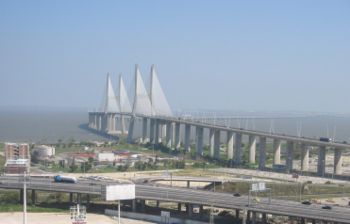
Lisbon`s public transport network is extremely far-reaching and reliable and has its Metro as its main artery, connecting the city centre with the upper and eastern districts. Ambitious expansion projects will increase the network by almost one third, connecting the airport, and the northern and western districts. Bus, funicular and tram services have been supplied by the Companhia de Carris de Ferro de Lisboa (Carris), for over a century.
A traditional public transport in Lisbon is the tram. Originally introduced in the 19th century, the trams were originally imported from the U.S. and called americanos. The original trams can still be seen in the Museu da Carris (the Public Transport Museum) ( Carris)
There are four suburban lines departing from Lisbon: the Cascais, Sintra and Azambuja lines as well as a fourth line to Setúbal crossing the Tagus river over the 25 de Abril Bridge.
The city is connected to the far side of the Tagus by two important bridges:
- The 25 de Abril Bridge, inaugurated (as Ponte Salazar) August 6, 1966, and later renamed after the date of the Carnation Revolution, was the longest suspension bridge in Europe and although made by the same engineers as the Golden Gate Bridge in San Francisco, it is not, as thought by some, a replica (the Golden Gate Bridge does not have X braces).
- The Vasco da Gama Bridge, inaugurated May 1998 is, at 17.2 Km, the longest bridge in Europe.
Lisbon is connected to its suburbs and the rest of Portugal by an extensive motorway network. There are three circular motorways around the city; the 2ª Circular, the CRIL and the CREL.
The Portela Airport with international flights to any destination worldwide, is located in the city.
Education in Lisbon
The city has several private and public secondary schools, primary schools as well as kindergartens. In Greater Lisbon area there are also international schools such as Saint Julian's School, the Carlucci American International School of Lisbon, St Dominic's International School, Deutsche Schule Lissabon, and Lycée Francais Charles Lepierre.
There are 3 major public universities in Lisbon: the University of Lisbon (founded in 1911 it is Lisbon's oldest higher education institution in continuous operation), the Technical University of Lisbon and the New University of Lisbon, providing degrees in the natural sciences, engineering, medicine, law, education, sports, architecture, social sciences and humanities. There is also a polytechnic institute, the Polytechnical Institute of Lisbon. Major private institutions of higher education include the Portuguese Catholic University, as well as the Modern University of Lisbon, the Lusiada University, the Lusófona University of Humanities and Technologies and the Autonomous University of Lisbon.
Greater Lisbon
see also Lisbon Metropolitan Area, Lisbon Region and Greater Lisbon
Like most big cities, Lisbon is surrounded by many satellite cities and towns. It is estimated that more than one million people enter Lisbon every day from the outskirts. Cascais and Estoril are among the most interesting neighbouring towns for night life. Beautiful palaces, landscapes and historical sites can be found in Sintra and Mafra. Other major municipalities around Lisbon include Amadora, Oeiras, Odivelas, Loures, Vila Franca de Xira and, in the south bank of the Tagus river estuary, Almada, Barreiro and Seixal.
Touristic attractions
Belém: Pristine Manueline
Along the Rio Tejo (Tagus River), is the historic neighbourhood of Belém. Its prime attraction is the grand Mosteiro dos Jeronimos. Construction started in 1501, and took 70 years to complete. During its construction, the monastery cost an equivalent of 70 kg of gold each year. Most of the construction costs were financed through the spice trade. It is a prime example of what is called Manueline architecture, with inspiration brought back from the explorations, as well as being influenced by the Gothic and Renaissance periods. Nearby is the Torre de Belém.
Bairro Alto: Nightlife
Bairro Alto (literally upper quarter in Portuguese) is an area of central Lisbon, Portugal. It functions as a residential, shopping and entertainment district. Today, the Bairro Alto is the heart of Lisbon's youth and of the Portuguese capital's nightlife. Lisbon's Punk, Gay, Metal, Goth, Hip Hop and Reggae scenes, all have the Bairro as their home, due to the number of clubs and bars dedicated to each of them. The fado, Portugal's national song, still survives in the new Lisbon's nightlife. The crowd is a mix of local and tourist, straight and gay, and almost anything else you can imagine.
Estação do Oriente: Architecture Marvel
Estação do Oriente (Orient Station) is one of the main transportation hubs of Lisbon, for trains, metro, buses and taxis. Its glass and steel columns are reminiscent of palms, making the whole structure fascinating to look at (especially in sunlight or when illuminated at night). It was desinged by the great architect Santiago Calatrava from Valencia (Spain). Cross through the shopping mall just across the street and you're in Parque das Nações (Park of the Nations), site of the 1998 World Expo.
Lisbon: Funicular Transportation
Transportation in Lisbon is more charming than most cities. Much is owed to its geography; much of Lisbon has been built on its seven hills. No visit to Lisbon is complete without riding the century old trams. The greatest attractions, though, are the funiculars, of which there are three. These are Elevador da Glória, Elevador da Bica and Elevador da Lavra. Perhaps the most picturesque is the Elevador da Bica, which passes through a charming residential neighbourhood just below Bairro Alto.
Sister cities
Curiosities
- Two European Union agencies are headquartered in Lisbon; the European Monitoring Centre for Drugs and Drug Addiction ( EMCDDA) and the European Maritime Safety Agency ( EMSA). The CPLP (Community of Portuguese Language Countries), is also headquartered in Lisbon.
- Lisbon is the original birthplace of fado music.
- The remains of Luís de Camões, author of the epic Os Lusíadas, can be visited at the Jerónimos Monastery. The remains of other great Portuguese men and women can be visited at the National Pantheon.
- Lisbon is served by Portela Airport, the largest in Portugal. Plans for construction of a new airport in Ota (50 km from Lisbon) have been around for years, with systematic postponements.
- The most famous purveyor of Pastéis de Nata, Pastéis de Belém, is located in the Belém neighbourhood of Lisbon.
Buildings
- Águas Livres Aqueduct, 18th century engineering masterpiece.
- Assembleia da República, housed in the Palácio de São Bento.
- Vasco-da-Gama-Tower
- Gare do Oriente
- Pavilhão Atlântico
Prominent people born in Lisbon
- Saint Anthony of Lisbon ( 1195- 1231)
- Pope John XXI, born Pedro Julião ( 1215- 1277)
- Antonio Vieira ( 1608- 1697), Jesuit
- Catherine of Braganza ( 1638- 1705), queen consort of King Charles II of England
- Richard William Church ( 1815- 1890)
- Egas Moniz ( 1874- 1955), physician, neurologist and Nobel Prize in Medicine in 1949
- Fernando Pessoa ( 1888- 1935), writer
- Amália Rodrigues ( 1920- 1999), fado / singer
- Mário Cesariny ( 1923- 2006), poet
- Alexandre O'Neill ( 1924- 1986), poet / writer
- Mário Soares (born 1924), politician
- Paula Rego (born 1935), painter, illustrator and printmaker
- Jorge Sampaio (born 1939), politician
- António Guterres (born 1949), United Nations High Commissioner for Refugees
- Durão Barroso (born 1956), President of the European Commission
- Pedro Santana Lopes (born 1956), politician
